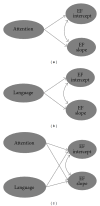The development of executive function in autism
- PMID: 22934168
- PMCID: PMC3420556
- DOI: 10.1155/2012/146132
The development of executive function in autism
Abstract
Autism is a common and often highly debilitating neurodevelopmental condition, whose core behavioral features are believed to be rooted in disrupted neurocognitive processes, including especially "executive function." Researchers have predominantly focused upon understanding the putative causal relationship between difficulties in EF and autistic symptomatology. This paper suggests, however, that the effects of individual differences in EF should be more far-reaching, playing a significant part in the real-life outcomes of individuals with autism, including their social competence, everyday adaptive behavior, and academic achievement. It further considers the nature of the EF-outcome relationship, including the possible determinants of individual differences in EF, and makes several recommendations for future research.
Figures


Similar articles
-
Beyond group differences: Exploring the preliminary signals of target engagement of an executive function training for autistic children.Autism Res. 2022 Jul;15(7):1261-1273. doi: 10.1002/aur.2735. Epub 2022 Apr 28. Autism Res. 2022. PMID: 35481725 Free PMC article. Clinical Trial.
-
Middle-childhood executive functioning mediates associations between early-childhood autism symptoms and adolescent mental health, academic and functional outcomes in autistic children.J Child Psychol Psychiatry. 2022 May;63(5):553-562. doi: 10.1111/jcpp.13493. Epub 2021 Aug 12. J Child Psychol Psychiatry. 2022. PMID: 34382216 Free PMC article.
-
Metacognitive Aspects of Executive Function Are Highly Associated with Social Functioning on Parent-Rated Measures in Children with Autism Spectrum Disorder.Front Behav Neurosci. 2018 Jan 10;11:258. doi: 10.3389/fnbeh.2017.00258. eCollection 2017. Front Behav Neurosci. 2018. PMID: 29375332 Free PMC article.
-
A review of executive functioning challenges and strengths in autistic adults.Clin Neuropsychol. 2022 Jul;36(5):1116-1147. doi: 10.1080/13854046.2021.1971767. Epub 2021 Sep 9. Clin Neuropsychol. 2022. PMID: 34499568 Review.
-
Intersectionality Within Critical Autism Studies: A Narrative Review.Autism Adulthood. 2022 Dec 1;4(4):281-289. doi: 10.1089/aut.2021.0014. Epub 2022 Dec 13. Autism Adulthood. 2022. PMID: 36777375 Free PMC article. Review.
Cited by
-
Atypical age-dependency of executive function and white matter microstructure in children and adolescents with autism spectrum disorders.Eur Child Adolesc Psychiatry. 2017 Nov;26(11):1361-1376. doi: 10.1007/s00787-017-0990-2. Epub 2017 Apr 26. Eur Child Adolesc Psychiatry. 2017. PMID: 28447268
-
Read my lips! Perception of speech in noise by preschool children with autism and the impact of watching the speaker's face.J Neurodev Disord. 2021 Jan 5;13(1):4. doi: 10.1186/s11689-020-09348-9. J Neurodev Disord. 2021. PMID: 33402099 Free PMC article.
-
Financial Literacy Skills Instruction Among Autistic Individuals: A Systematic Review.J Autism Dev Disord. 2025 May 3. doi: 10.1007/s10803-025-06853-5. Online ahead of print. J Autism Dev Disord. 2025. PMID: 40317348
-
Using the NIH Toolbox to Assess Cognition in Adolescents and Young Adults with Autism Spectrum Disorders.Autism Res. 2021 Mar;14(3):500-511. doi: 10.1002/aur.2399. Epub 2020 Oct 2. Autism Res. 2021. PMID: 33006263 Free PMC article.
-
Altered engagement of the speech motor network is associated with reduced phonological working memory in autism.Neuroimage Clin. 2023;37:103299. doi: 10.1016/j.nicl.2022.103299. Epub 2022 Dec 23. Neuroimage Clin. 2023. PMID: 36584426 Free PMC article.
References
-
- Howlin P, Goode S, Hutton J, Rutter M. Adult outcome for children with autism. Journal of Child Psychology and Psychiatry and Allied Disciplines. 2004;45(2):212–229. - PubMed
-
- Howlin P, Mawhood L, Rutter M. Autism and developmental receptive language disorder—a follow-up comparison in early adult life. II: social, behavioural, and psychiatric outcomes. Journal of Child Psychology and Psychiatry and Allied Disciplines. 2000;41(5):561–578. - PubMed
-
- Kanner L. Childhood Psychosis: Initial Studies and New Insights. New York, NY, USA: Winston/Wiley; 1973.
-
- Sigman M, Ruskin E. Monographs of the Society for Research in Child Development, Serial no. 256. Vol. 4. Chicago, Ill, USA: University of Chicago Press; 1999. Social competence in children with autism, Down syndrome and other developmental delays: a longitudinal study. - PubMed
-
- Szatmari P, Bartolucci G, Bremner R, Bond S, Rich S. A follow-up study of high-functioning autistic children. Journal of Autism and Developmental Disorders. 1989;19(2):213–225. - PubMed
LinkOut - more resources
Full Text Sources

